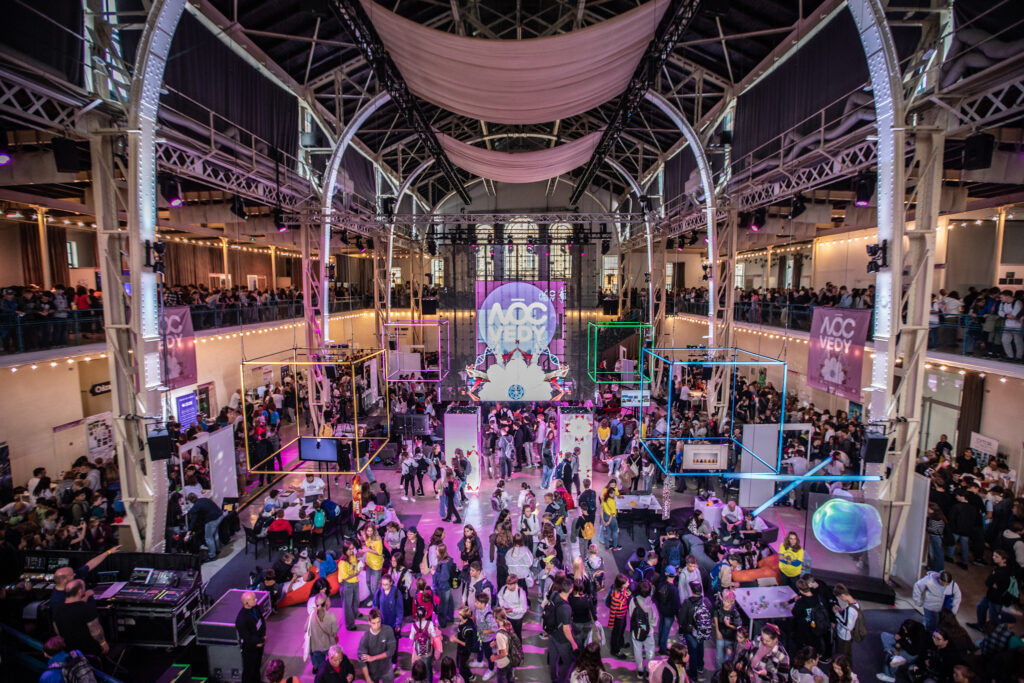
On Friday, September 27, Bratislava’s Old Market Hall was filled with crowds of science enthusiasts from academia, the private sector, the state sphere, but especially the general public. The European Science Night brought an engaging program to the capital, which also took place in the V-club, Lab.cafe, Aurélium and Cafe LAMPY.
The Slovak Academy of Sciences was represented in panel discussions, some scientists were in the role of independent lecturers. In a panel discussion on the topic Will interdisciplinarity save us? was also discussed by the President of the SAS, Pavol Šajgalík, who, together with other speakers, agreed that it is necessary to create a common platform for closer cooperation and discussion.
“In my opinion, it is important to constantly cross borders and get into discussions with other scientific disciplines, with different education systems. A platform should be created in our environment where we will all talk more together with a clear perspective of future progress,” said the President of the SAS.
An important topic of the event was the project of building the European Solar Telescope, which also includes astronomers from the Slovak Academy of Sciences.
“It is extremely important for Slovakia to participate in the construction of the European solar telescope. We have the human potential and professional expertise to become an important player in this pan-European project, which will move us among the elite in the European research area in the field of research of our nearest star,” said Peter Gomory, Director of the Astronomical Institute of the Slovak Academy of Sciences.
The Slovak Academy of Sciences was represented by a total of 20 stands in the capital.
“The main attraction of our stand was the Lego world. In the V-club, we took up an area of approximately two square meters, where we illustrated how processes work in a river landscape, what types of land cover we know, how we use the landscape, but also how the relationships between urban and rural landscapes work. We also draw the attention of passers-by to the importance of biodiversity in the protection of meadow ecosystems,” said Tomáš Goga from the Institute of Geography of the Slovak Academy of Sciences.
The Institute of Inorganic Chemistry had its stand in the Old Market Hall and called it the Laboratory of Miracles: Inorganic Adventures.
“Martian soil contains about 25% oxygen, and we tried to demonstrate melt chemistry on it, specifically how to make oxygen and various metals from this soil. It is impressive for visitors when they can literally touch the soil from Mars, which we have produced based on data from the Opportunity and Curiosity rovers,” said Viliam Pavlík from the Institute of Inorganic Chemistry of the Slovak Academy of Sciences.
The Polymer Institute regularly participates in the European Science Night and this year it has prepared specific demonstrations of plastics for visitors, which are not only PET bottles, but have a wide range of uses, for example in the pharmaceutical industry. The stand of the Center for Experimental Medicine was called Together to Health. During their visit, visitors could also be transported to virtual reality, where they experimented with their fear of heights.
“It was very pleasing for us to see the public interest we encountered at the European Science Night this year. The topic of health is extremely important to people and we were fully prepared to be able to answer all kinds of questions. I specialize in monitoring the effects of drugs and toxic substances on the body, which is still an unexplored area in many respects and raises a lot of question marks, and in this sense our visitors also reflected on it,” said Pavol Boďo from the Institute of Experimental Pharmacology and Toxicology of the Slovak Academy of Sciences.
The SAS had a rich representation not only in stands, but also on stages. In the V-club, Viktória Sunyík from the Institute of Experimental Psychology of the Centre of Social and Psychological Sciences of the Slovak Academy of Sciences presented a lecture on scientific thinking. Tomáš Hromádka from the Institute of Neuroimmunology of the Slovak Academy of Sciences talked about artificial intelligence from the point of view of neuroscience. Adam Kantor from the Centre of Plant Biology and Biodiversity of the Slovak Academy of Sciences spoke at the workshop on citizen science. The evening lecture program in the Old Market Hall belonged to the topic COMPLEXITY: The complexity of our situation in the midst of the climate crisis, which was looked at by SAS researchers, representatives of four scientific fields – philosophy, history, physics and astronomy. On the stage performed: Richard Stahel from the Institute of Philosophy of the Slovak Academy of Sciences, Oliver Zajac from the Institute of History of the Slovak Academy of Sciences, Natalia Salomé Móller from the Institute of Physics of the Slovak Academy of Sciences and Peter Gömöry from the Astronomical Institute of the Slovak Academy of Sciences.
Edited by: Monika Tináková
Photo: Katarína Gáliková



